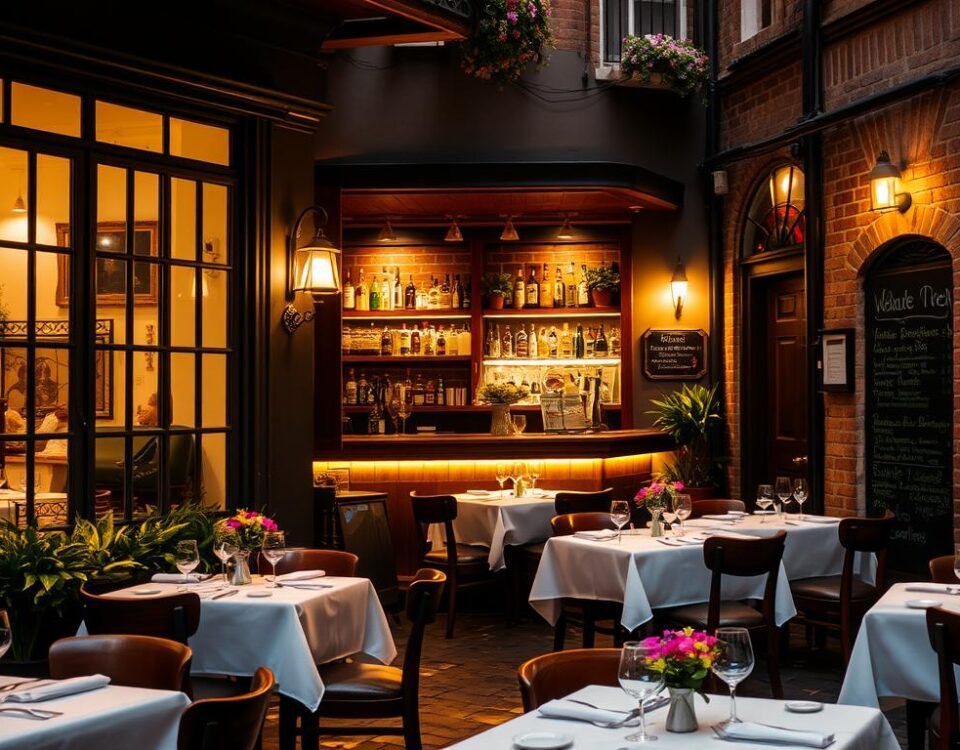
How to Eat Like a Local in Athens Without Getting Lost in Touristy Traps
June 9, 2025
7 Traditional Dishes to Try in Vienna Before You Leave
June 10, 2025Did you know 70% of visitors leave Prague without tasting a single dish locals actually eat? I nearly became part of that statistic until a rainy afternoon changed everything. While wandering cobblestone alleys, the scent of caramelized onions and roasted meat led me to a tucked-away tavern. There, I discovered svíčková—a creamy beef dish my Czech friend later called “the edible equivalent of a childhood hug.”
That meal taught me how recipes here whisper stories of resilience and celebration. From dumplings shaped by generations to soups simmered with seasonal roots, every bite mirrors the nation’s soul. But it’s not just about nostalgia—today’s chefs reimagine classics with bold, global flair while honoring their roots.
In this guide, I’ll show you how to sidestep clichés and savor meals that feel like coming home, whether you’re here for three days or three weeks. You’ll learn why locals debate bread dumplings like sports fans and where to find the perfect balance of tradition and innovation.
Key Takeaways
- Essential tips for avoiding tourist traps while exploring local flavors
- How traditional dishes connect to Czech history and daily life
- Spotlight on family-owned spots preserving century-old recipes
- Modern eateries putting creative spins on comfort classics
- Seasonal ingredients that define the region’s culinary calendar
Introduction: My Czech Culinary Journey in Prague
I never expected a simple bread dumpling to redefine comfort food until my first lunch here. A server slid a plate of vepřo-knedlo-zelo toward me—roast pork with cabbage—and whispered, “Eat like you mean it.” The pillowy dumpling soaked up juices like a flavor sponge, instantly explaining why locals guard family recipes like national treasures.
Each meal became a history lesson. At a riverside tavern, I learned goulash arrived via Hungarian influence but gained Czech character through caraway and dark beer. “We take what’s good and make it ours,” chuckled a chef while stirring a copper pot. His words stuck as I tasted plum-filled desserts from Moravian orchards and sipped soups thickened with root vegetables.
The people turned dishes into memories. A baker taught me to score rye loaves using his grandmother’s knife. Market vendors insisted I try pickled cheese before buying. “This isn’t just eating,” a butcher explained, handing me smoked meat on wax paper. “It’s how we say hello.”
These experiences rank among the one best parts of my travels because they transcended menus. What began as curiosity about food prague offers became a crash course in living well—through generous portions, shared tables, and recipes that outlasted empires.
“Come hungry, leave belonging,” a café owner told me. After three weeks of second helpings and third opinions on proper dumpling size, I finally understood.
Discovering the Prague authentic food guide
My quest for real Czech flavors began in an unexpected spot—a basement wine bar where regulars argued over the best roast duck spots. A laminated menu tucked under a beer coaster became my treasure map. It listed family-run restaurants where recipes survived wars and trends.
Locals taught me to judge restaurants by their bread baskets. “If they serve factory rolls, walk out,” a chef warned. True spots bake rye loaves daily or partner with nearby bakeries. I found one place using 19th-century ovens—their dumplings tasted like parchment-wrapped history.
Choosing where to eat depends on cravings. Want svíčková? Follow office workers to lunch-only taverns. Craving schnitzel? Seek pubs with handwritten specials. I’ll never forget the cellar restaurant where my goulash arrived in a bread bowl still warm from the oven.
The magic happens in places with creaky floors and framed sepia photos. At a riverside spot, the owner showed me his great-grandmother’s cookbook stained with vanilla extract. “We don’t reinvent,” he said, stirring a pot of sauerkraut. “We remember.”
These restaurants don’t need flashy signs. Their menus speak through braised meats, herb-infused broths, and desserts plated with pride. Find them, and you’ll taste stories no guidebook can capture.
Must-Try Traditional Czech Dishes
The first time I watched a chef prepare steak tartare tableside, I realized Czech cuisine thrives on edible theater. Locals don’t just eat—they participate in centuries-old rituals where presentation matters as much as flavor.
Beef Steak Tartare and Its Unique Preparations
At a dimly lit brasserie, I learned why this raw meat dish sparks devotion. The chef mixed minced sirloin with mustard, capers, and a raw egg yolk while explaining how common steak mistakes ruin texture. “We use only chuck cut twice by hand,” he said, arranging the mixture on toasted rye.
Steamed bread dumplings often accompany tartare here. Their pillowy softness balances the meat’s richness—a contrast I’ve never encountered elsewhere. Some spots even serve it with fried onion strings for crunch.
Kulajda and Other Hearty Soups
Nothing prepared me for Kulajda’s creamy tang. This potato-based soup combines earthy mushrooms with vinegar’s sharpness, topped with a silky poached egg. A waiter taught me to swirl the yolk into the broth, creating golden ribbons that cling to every spoonful.
Winter visits reveal more soul-warming dishes:
- Česnečka: Garlic soup with smoked meat and melted cheese
- Dršťková: Tripe stew with paprika and marjoram
- Zelná polévka: Sauerkraut soup with sausage and caraway
These soups showcase Czech ingenuity—transforming humble ingredients into complex flavors. As one cook told me while grating horseradish into a broth: “Hunger invented our best recipes.”
Savory Classics: Svickova and Roast Duck
A cloud of steam rose as my fork pierced the beef in svíčková, releasing the scent of root vegetables and black pepper. This dish taught me why Czechs worship their sauces—the velvety blend of cream, carrot, and parsley root clung to every slice like edible velvet.

When Tradition Meets Technique
Chefs debate svíčková’s sauce like artists arguing over brushstrokes. One version used 24-hour marinated beef, another added a splash of wine for brightness. “Grandma’s secret?” laughed a cook, pointing to her copper pot. “Stir clockwise until your arm cramps.”
Duck That Defies Expectations
Roast duck surprised me with its range. A modern bistro served it with plum glaze and crispy kale, while a countryside inn paired it with sauerkraut dumplings. The best version? Crackling skin glazed with honey and caraway—a perfect balance of sweet and earthy.
Both dishes shine with local wine. Try a Moravian Riesling with svíčková to cut through the cream, or a dark lager with duck to highlight its smoky notes. As one chef told me: “We don’t eat to live here—we live to eat well.”
Delicious Accompaniments and Sides
The true magic of Czech meals often lies in the supporting cast. While mains like svíčková command attention, bread dumplings and potato salad work behind the scenes to create harmony on the plate. These sides aren’t afterthoughts—they’re essential counterpoints to rich flavors.
Bread Dumplings & Potato Salad
Watching a chef prepare bread dumplings changed my understanding of starch. Day-old rye loaves get diced, steamed, and kneaded into fluffy pillows that soak up sauces like culinary sponges. “They should hold shape but melt when chewed,” explained a cook testing dough firmness with her palm.
Czech potato salad plays a different game. Waxy potatoes hold their bite against crisp carrots and peas, while a mayo-mustard dressing gets depth from melted cheese. I learned to spot quality by the tang—proper versions use fermented curd instead of store-bought shreds.
| Side Dish | Texture | Flavor Role | Pairing Tip |
|---|---|---|---|
| Bread Dumplings | Pillowy soft | Sauce absorber | Serve with braised meats |
| Potato Salad | Creamy crunch | Bright contrast | Balance smoked dishes |
| Sauerkraut | Tangy crisp | Cut through fat | Pair with roasted duck |
Get the pairing right, and your plate becomes a conversation. Try dumplings with goulash’s paprika heat, or match potato salad’s earthiness with schnitzel’s golden crust. A tavern owner once told me: “Good sides make strangers ask for recipes—great ones make them ask for seconds.”
Mouthwatering Schnitzel Variations
The crunch echoed through the dining room like a standing ovation when my first schnitzel arrived. Golden breadcrumbs shattered under my fork, revealing juicy pork thinner than my notebook. This wasn’t just fried meat—it was edible architecture balancing crispness and tenderness.
Traditional Pork Schnitzel vs. Modern Twists
Classic versions use pork knuckle pounded paper-thin. “The hammering releases natural juices,” a chef explained while demonstrating proper technique. His schnitzel covered the plate, edges curling like autumn leaves. Side of tart cranberry sauce cut through the richness perfectly.
Newer spots experiment boldly. One bistro used duck breast with hazelnut crust. Another stacked venison cutlets with garlic aioli. “We respect tradition but play with textures,” said a cook serving schnitzel on beetroot purée. The best modern twist? Pork belly schnitzel—crispy outside, molten fat within.
Meat Matters: Selecting the Perfect Cut
Quality depends on meat preparation. Traditional spots brine cuts for 48 hours. Modern kitchens often use sous-vide before frying. Watch for these signs of excellence:
- Even thickness across entire cutlet
- Breadcrumbs sticking without grease pools
- Juices seeping into sides, not plate
| Feature | Traditional | Modern |
|---|---|---|
| Cut | Pork knuckle | Duck/venison |
| Breading | Plain breadcrumbs | Spiced/herbed |
| Side | Potato salad | Seasonal slaws |
| Innovation | – | Sous-vide prep |
Despite new approaches, traditional Czech methods remain popular. As my waiter said while refilling my beer: “Some sounds should never change—like schnitzel’s first crunch.”
Exploring Hearty Soups and Stews
I discovered goulash’s magic during a downpour in a cellar tavern. Steam rose from a copper pot as the chef ladled crimson broth over tender beef, whispering, “This is how we survive winters.” More than just stew, it’s a cultural chameleon—every region adds its fingerprint to this Hungarian-born classic.
Goulash and Its Regional Interpretations
True Czech goulash balances spice and patience. Caraway seeds toast with onions until fragrant before meeting paprika-rubbed meat. “Slow fire makes quick friends,” joked my cooking instructor as we stirred a pot for three hours. The result? Fork-tender beef swimming in gravy thick enough to stand a spoon in.
Local variations surprised me:
- Bohemian style adds dark beer for malty depth
- Moravian versions use sweet peppers and tomato paste
- Mountain inns toss in wild mushrooms for earthy notes
A food tour revealed the perfect pairing: pilsner. The beer’s crisp bitterness cuts through richness like a sled through snow. “Never trust a goulash without a foam mustache,” laughed my guide, clinking glasses with me at our fourth tasting stop.
“My grandfather taught me to judge goulash by its bubbles—if they pop slowly, you’ve got love in the pot.”
These stews connect generations through simmering pots and shared ladles. Whether served in bread bowls or with dumplings, each bite honors traditions that outlasted empires.
Sweet Endings: Fruit Dumplings, Kolache, and Buchty
I nearly missed dessert at my first Czech lunch—until a grandmother slid a plate of plum dumplings toward me with a wink. “Meals here don’t end,” she said. “They pause.” These sweet foods aren’t mere finales but essential chapters in the czech food story, woven into lunches as naturally as bread baskets.

Seasonal Fruit Dumplings and Their Rich Fillings
Biting into a steamed dumpling reveals nature’s candy. Summer brings apricot pockets dusted with poppy seeds. Autumn versions burst with tart plums or sweet blueberries. “We use what trees give us,” explained a baker shaping dough around whole strawberries. The taste? Like biting through clouds into sunshine.
Authentic Kolache Traditions
Kolache taught me patience. At a village bakery, I watched dough rise three times before filling. “Quick foods don’t last generations,” the baker noted, brushing egg wash over prune-filled rounds. Some spots now add lemon zest or almond cream, but purists insist on farmer’s cheese—the way great-grandmothers did it.
What surprised me most? These treats often arrive mid-meal. “A bit of sweetness balances life’s sour moments,” a chef told me while serving buchty—yeast buns oozing jam. Whether you try one or five, each bite feels like joining a family recipe passed hand to hand for centuries.
Beer and Snacks: Pairing Czech Brews with Local Nibbles
I learned Czech beer culture isn’t about drinking—it’s about conversation seasoned with foam. At a bustling pub, my first Pilsner Urquell arrived with a golden wedge of fried cheese. “This is how we watch sunsets,” laughed my neighbor, clinking his glass against mine.
Pub Rituals and Flavorful Bites
A well-set table here tells stories. Checkered cloths hold shareable plates of chlebíčky—open-faced sandwiches crowned with egg and ham. These aren’t just snacks; they’re edible invitations to linger. My favorite thing? How pickled peppers cut through rich beer like citrus through fog.
Fried cheese became my go-to. The crunch of breaded Edam gives way to molten creaminess that dances with hoppy brews. “We pair textures, not just flavors,” explained a bartender, sliding me another amber pint.
| Snack | Texture | Best Beer Pair | Quirk Factor |
|---|---|---|---|
| Fried Cheese | Crispy/gooey | Dark Lager | Served with tartar sauce |
| Chlebíčky | Crunchy/creamy | Pilsner | Topped with radish roses |
| Utopenec | Tangy/tender | Amber Ale | Pickled sausage in jars |
The best thing about these pairings? They turn strangers into friends. Shared bites at worn wooden tables spark debates over which brewery makes the crispiest pretzels. One thing’s certain—you’ll leave knowing beer here isn’t just a drink. It’s the glue holding together nights filled with laughter and second helpings.
Conclusion
The true essence of Czech culture reveals itself not in museums, but on steaming plates and shared tables. My journey through this city’s culinary landscape taught me that every dumpling fold and simmered sauce carries generations of pride. From cellar taverns to sunlit bistros, meals here balance heritage with playful reinvention.
Dishes act as edible archives. A schnitzel’s crunch echoes wartime resilience, while fruit-filled pastries sweeten memories of orchard harvests. What surprised me most? How today’s chefs honor the past without becoming prisoners to it—smoking meats with new woods, plating classics as modern art.
The country’s kitchens thrive on contrast. Timeworn recipes meet bold experimentation, creating flavors that feel both familiar and thrillingly new. This duality makes every bite a discovery—whether you’re savoring grandmother-approved stews or sipping craft beer infused with wild herbs.
I urge you to wander beyond menus. Let rye bread crumbs guide you through cobblestone lanes. Chat with butchers about their brining methods. Taste how a single city can weave medieval traditions into twenty-first-century creativity.
Pack curiosity instead of expectations. The most memorable meals here aren’t just eaten—they’re felt. Now’s your turn to pull up a chair where history and innovation clink glasses. Prague’s soul waits in that first bite of country-made cheese, that golden sip of broth, that unexpected flavor that whispers: “Welcome home.”
FAQ
What’s the best way to pair beer with Czech dishes?
I love matching Pilsner Urquell with fried cheese or roast duck—the crisp bitterness cuts through rich flavors. Dark lagers like Kozel work wonders with goulash or beef dishes.
Are there vegetarian options in traditional cuisine?
Yes! Try smazený sýr (fried cheese) or knedlíky with seasonal fruit. Many soups, like kulajda, are creamy and meat-free if you ask.
How do I eat bread dumplings properly?
Tear them into chunks and soak up sauces like the creamy one from svíčková. They’re meant to balance hearty meats, so don’t be shy with gravy!
Is beef steak tartare safe for tourists?
I’ve enjoyed it at trusted spots like Café Louvre. Freshness is key—look for places that grind the meat daily and serve it with garlic toast.
What makes Czech potato salad unique?
It’s creamier than others, with mayo, mustard, and pickles. Some add apples or hard-boiled eggs. Perfect alongside schnitzel or pork roast.
Where can I try authentic kolache?
Local bakeries like Antonínovo Pekařství nail the poppy seed or plum fillings. Morning markets often have warm, freshly baked versions too.
Why is pork knuckle so popular here?
It’s slow-roasted until tender, with crackling skin. Pair it with horseradish and mustard at beer halls—it’s a flavorful, shareable dish.
Can I find modern twists on classic dishes?
Absolutely! Trendy spots like Lokál Dlouhá update classics, like duck confit with red cabbage slaw or beetroot-infused dumplings.



